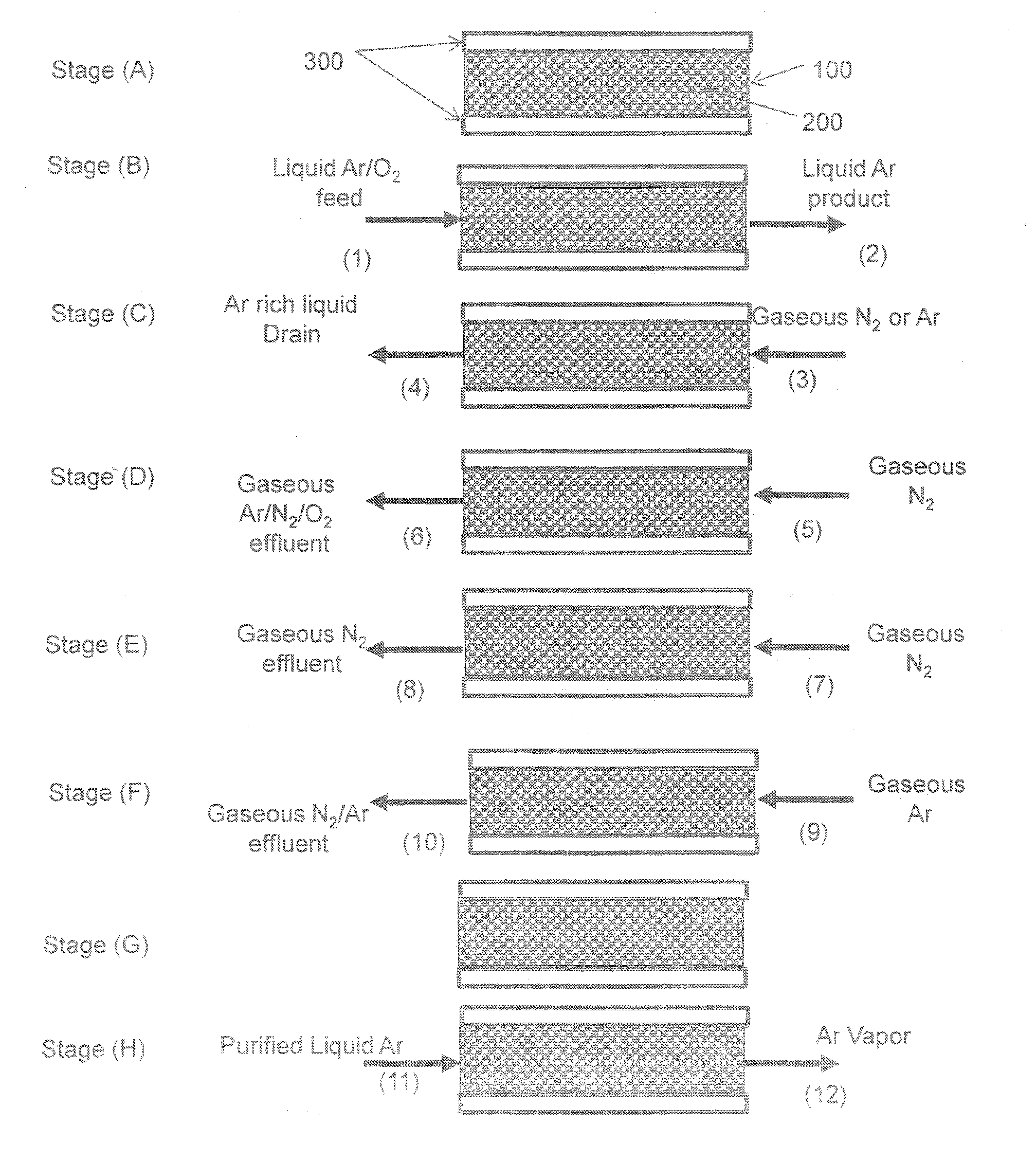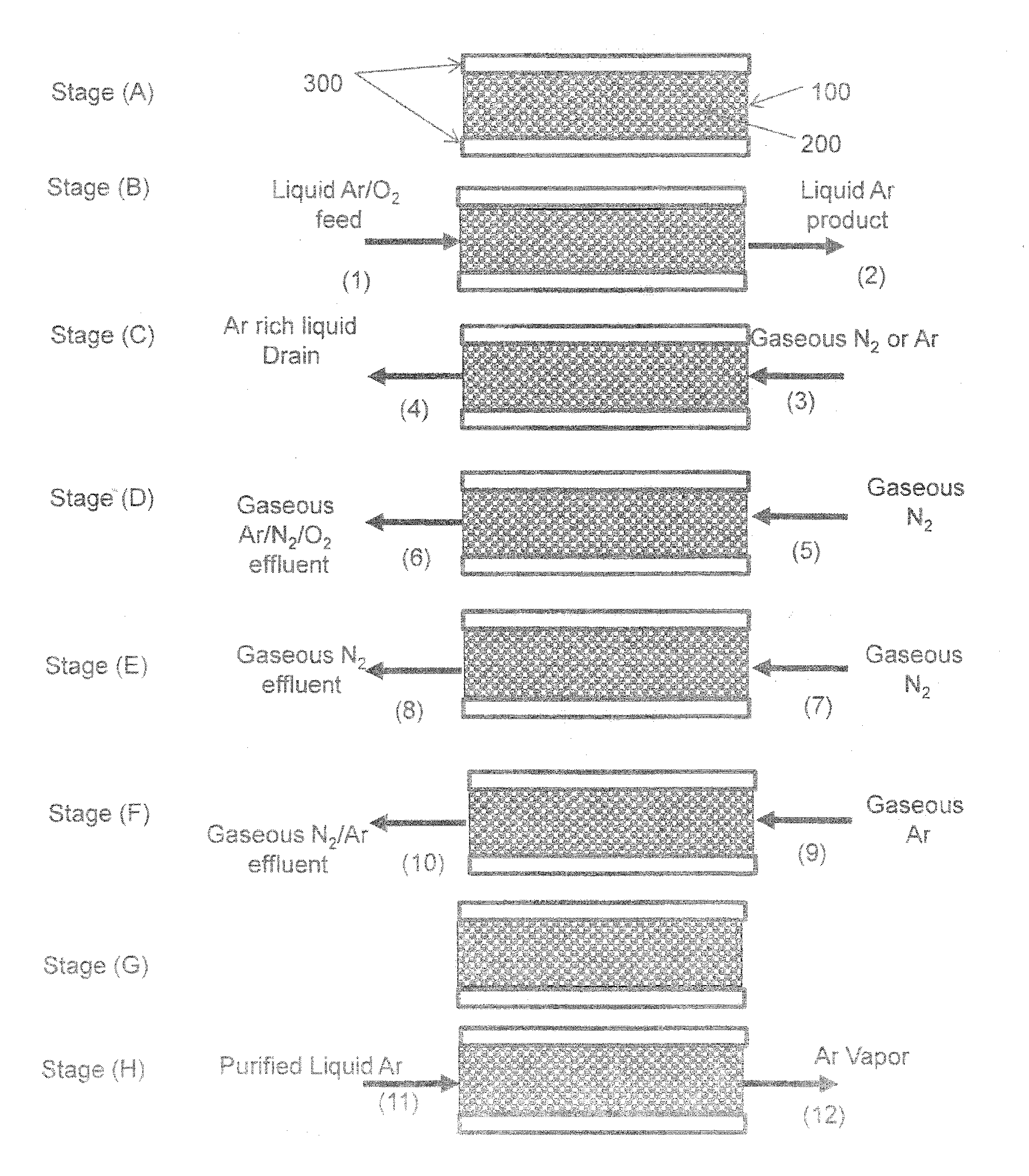Purification of argon through liquid phase cryogenic adsorption
a cryogenic adsorption and liquid phase technology, applied in the direction of cold treatment separation, liquefaction, lighting and heating apparatus, etc., can solve the problems of argon oxygen presence, high cost of adsorption process, and constant addition of considerable cost to the adsorption process, so as to reduce the capital cost and reduce the cost of capital
- Summary
- Abstract
- Description
- Claims
- Application Information
AI Technical Summary
Benefits of technology
Problems solved by technology
Method used
Image
Examples
example 1
TSA Process Cycle Using Sample A
Preparation and Cool-Down of Adsorbent Bed:
[0067]Sample A (266.58 g), a 42% lithium exchanged on an equivalent charge basis zeolite 4A, the development of which is described below (see Example 3), was loaded on a pilot plant bed. The length of the bed was three feet and the internal diameter of the bed was 0.88 inches. The bed was purged with gaseous nitrogen at 15 psig and 300 degrees Kelvin overnight. The nitrogen flow rate was 5 slpm. The gaseous nitrogen flow was discontinued and a gaseous argon purge was initiated at 15 psig and 300 degrees Kelvin with a gaseous argon purge time of no less than 20 min. The argon flow rate was 7.2 slpm.
[0068]Subsequent to the argon purge, the flow through the bed was discontinued and passive cooling of the bed was initiated by flowing liquid nitrogen into the jacket that surrounds the absorbent bed. The bed was cooled for at least 1 hour, or until the temperature as measured by a thermocouple in the middle of the ...
example 2
Alternative TSA Process Cycle Using Sample A
Preparation and Cool-Down of Adsorbent Bed:
[0078]The preparation and cool-down of the adsorbent bed was identical to that provided for Example 1, above. Sample A (92.24 g) was loaded on the pilot plant bed. The length of the bed for this example was one foot and the internal diameter of the bed was 0.88 inches. The bed was purged with gaseous nitrogen and argon as described in Example 1.
[0079]Subsequent to the argon purge, the flow through the bed was discontinued and passive cooling of the bed was initiated as described in Example 1. Following the passive cooling step, purified liquid argon at 40 slpm was introduced from the bottom portion of the bed towards the top portion of the bed for at least a 45 minute period or until the bed temperature, as measured by the thermocouple, reached 90 degrees Kelvin.
First Purification / Breakthrough Step:
[0080]When the bed temperature reached 90 degrees Kelvin, the liquid argon flow was discontinued and...
example 3
Preparation of Sample A (42% Lithium Exchange of Commercial 1.0 mm 4A+12% Actigel®)
[0086]A commercially produced zeolite 4A sample with 12% Actigel® in beaded form, having an average particle size of 1.0 mm was obtained from Zeochem LLC of Louisville, Ky.
[0087]On a dry weight basis, 450 g of the commercially produced sample (562 g wet weight) was stirred in a lithium chloride (LiCl) solution (60.71 g LiCl crystals dissolved in 1500 ml deionized water) for 2 hours at a temperature of 90 degrees Centigrade. This exchange was repeated two more times. After the first two exchanges, the beads were decanted and washed by stirring in 2000 ml deionized water for 15 minutes at 90 degrees Centigrade. Decant and wash steps were repeated two more times. For the final washing step after the third exchange, the beads were placed in a 1.0 inch diameter glass column and using a peristaltic pump, 20 Liters deionized water were pumped through the column at rate of 80 ml / minute at 80 degrees Centigrad...
PUM
 Login to View More
Login to View More Abstract
Description
Claims
Application Information
 Login to View More
Login to View More - R&D
- Intellectual Property
- Life Sciences
- Materials
- Tech Scout
- Unparalleled Data Quality
- Higher Quality Content
- 60% Fewer Hallucinations
Browse by: Latest US Patents, China's latest patents, Technical Efficacy Thesaurus, Application Domain, Technology Topic, Popular Technical Reports.
© 2025 PatSnap. All rights reserved.Legal|Privacy policy|Modern Slavery Act Transparency Statement|Sitemap|About US| Contact US: help@patsnap.com



